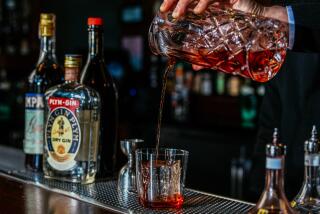Promo Records May Play a Better Tune
- Share via
Question: Do promotional recordings have any greater value than mass-circulated records?
--B.I.
Answer: Some record collectors we queried said that it depends on the artist and any changes that were made between the pressing of the promo and the final version for public consumption. More often than not, they said, the promotional copy has somewhat more value if for no other reason than they are limited in supply.
As you know, promotional records are distributed to radio stations for possible airing before mass distribution. Usually they are so marked on the label.
Q: You’ve answered a lot of questions about bottles, but what about jars used for preserving food? I understand that they can be quite valuable.
--A.L.
A: Jars attract a great deal of attention among collectors. Color and size are important. Also important is the way the jar is secured, because sealing devices have varied greatly over the years. For example, older jars were sealed with wax used in conjunction with metal or cork lids. The Mason jar, invented by John Mason of New York, came into use just before the Civil War and relied on a rubber ring and a zinc screw cap.
In reviewing catalogues and other periodicals, it appears that the more bizarre the jar-sealing device, the more valuable the jar is to collectors--even though the sealing mechanism may never have caught on with the public. Closure devices were in a wide variety of designs involving everything from screws to metal fasteners.
Preserving jars can be quite ornate and may carry prized embossed designs. Needless to say, they usually attract crowds at flea markets and dealer shows.
Q: Is there a way to date some of the Dunhill pipes in my collection?
--C.O.
A: A dealer told us that London-produced Alfred Dunhill pipes carried a coded manufacture date until 1954. If there is no number, it was manufactured after that year.
Q: How rare are the old Victor cylinder phonograph machines?
--T.M.
A: Quite a few were produced, and a large number are still in circulation. To be sure, collectors are still glad to find a Victor or a Columbia phonograph, but they don’t generate the value that more obscure brands do. Catalogue listings show a wide range of prices on these machines from about $100 to more than $2,000 for rare machines in elaborate mahogany cases.
Q: When were Hostetter bitters bottles manufactured?
--C.H.
A: Jacob Hostetter lived in Lancaster County, Pa., in the early 19th Century. He was a doctor who produced his own bitters (liquid of some alcoholic content and advertised as a cure for a variety of illnesses), which became popular at the time.
Hostetter bitters bottles are sought by collectors and have individually sold for up to $30 or more each, according to catalogue listings. Like many other similar products of the time, they were aggressively advertised with the advertising itself also commanding collector attention.
Bitters can be traced to early 18th-Century England; they became popular in this country among the Colonists. The attitude that bitters contained some medicinal value appears to have prevailed up to the Civil War.
Q: In the field of aviation memorabilia and the development of aviation, what one museum would you recommend visiting?
--G.A.
A: There are many fine aviation museums throughout the country. One that we’ve enjoyed over the years is the Smithsonian Institution’s National Air and Space Museum in Washington, which takes you from the dawn of aviation to the Space Age.
Ronald L. Soble cannot answer mail personally but will respond in this column to questions of general interest about collectibles. Do not telephone. Write to Your Collectibles, You section, The Times, Times Mirror Square, Los Angeles 90053.
More to Read
The biggest entertainment stories
Get our big stories about Hollywood, film, television, music, arts, culture and more right in your inbox as soon as they publish.
You may occasionally receive promotional content from the Los Angeles Times.










